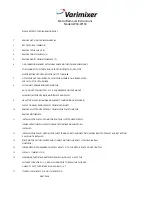
Input Channel module 7718
3-3
Revision B2005-2
B-Type
61414
,QSXW
#
*DLQ
The input gain is continuously variable from +10dB (minimum) to +60dB. Combined
with the use of the -20dB pad, this allows the use of a wide range of input devices
including ribbon, dynamic, electret and capacitor microphones; CD-players, Mini
Disc and Reel to Reel tape machines etc.
61415
053
G%
#
3DG
#
6ZLWFK
The ‘-20’ switch puts a 20dB attenuation pad in series with the I/P signal.
Use the -20dB pad when the input is at line level, or to reduce the overall gain by 20
dB.
61416
3KDVH
#
&KDQJH
#
‘
Use the ‘Ø’ switch to change the phase of the input signal.
When this function is selected, the incoming signal has its phase changed by 180°.
61417
7;
9
#
3KDQWRP
#
3RZHU
The 48V switch connects phantom power to the I/P line. This can be used to supply
power to most makes of capacitor and electret microphones.
61418
26&
2
31*
#
%XV
#
6HOHFW
The ‘~’ switch connects the OSC/PNG bus to the input amplifier.
You may select a sine wave tone for line-up purposes, or pink noise for loudspeaker
calibration (selectable on OSC/PNG/COMMS module).
61419
,QSXW
#
$PSOLILHU
#
3)/
An extra PFL switch for monitoring the input amplifier only. Very useful when fault
finding; e.g. if signal is present at input amplifier, but not at the main PFL, then the
fault will be in a circuit between the input amplifier and the main VCA.
6141:
$X[LOLDU\
#
6HQGV
There are 28 mono Auxiliary sends or 14 stereo sends. Each send can be switched
on or off and pre or post fader independently. LEDs to the left-hand side of each
switch illuminate when a switch is selected. When the LEDs are not illuminated, each
section is connected post fader and OFF.
Mono mode
The dual-concentric potentiometers in each section provide indi-
vidual level controls for 28 mono auxiliary sends.
Stereo mode
The dual-concentric potentiometers in each section change
function. The upper potentiometer is the auxiliary send level
control and the lower potentiometer becomes the balance
control.
Stereo mode selection is a ‘global mode’ controlled from the
CCM (see
E.g. If Auxiliary 1 is selected ‘STEREO’ on the CCM, the “SET” LED in the AUX1
section on all input channels will illuminate and all AUX1 sections are stereo sends.
Summary of Contents for B-Type
Page 1: ...Audio Mixing Console 056 6 10 n 95 4 1 07 g8 2...
Page 6: ...vi General Precautions B Type Revision B2005 2...
Page 8: ...viii Introduction B Type Revision B2005 2...
Page 48: ...2 20 Central Control Module 7896 B Type Revision B2005 2...
Page 86: ...6 10 Group Module 7756 B Type Revision B2005 2...
Page 96: ...7 10 Grand Master Group module 7795 B Type Revision B2005 2...
Page 106: ...9 4 Auxiliary Output Module 7468 B Type Revision B2005 2...
Page 122: ...11 10 Osc Comms PFL module 7758 M Type groups B Type Revision B2005 2...
Page 130: ...12 8 Osc Comms PFL module 7635 F Type groups B Type Revision B2005 2...
















































